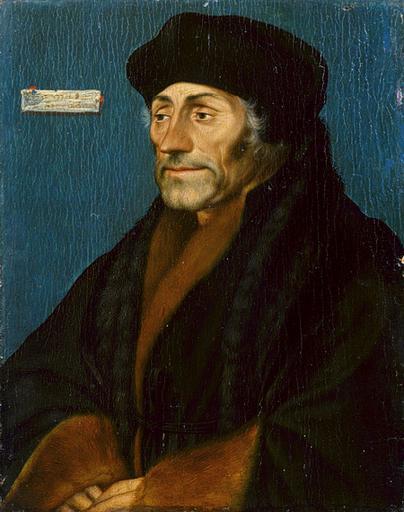MAKE A MEME
View Large Image

| View Original: | Erasmus_of_Rotterdam,_humanist_scholar_(3694763842).jpg (450x571) | |||
| Download: | Original | Medium | Small | Thumb |
| Courtesy of: | commons.wikimedia.org | More Like This | ||
| Keywords: erasmus henry viii henryviii 16th century 16thcentury portrait netherlands humanist holbein people Of the several versions and many replicas of Hans Holbein the Younger's portraits of Erasmus of Rotterdam that survive, this small panel is one of probably five painted by the artist himself. Shown in half-length three-quarter profile, his hands just visible between the fur cuffs of his coat, Erasmus is depicted as he appeared around 1530, when he was about sixty. Tufts of the sitter's gray hair poke out from beneath his black cap, deep lines mark the area around his mouth, and the skin shows signs of loosening below his stubbly chin, but the sensitivity and intensity of Erasmus's scholarly mind are still richly apparent in his piercing dark eyes. Holbein's close association with the humanist and scholar is reflected not only in these and other admiring portraits but also in the letters of introduction written on Holbein's behalf by Erasmus to his friends in England when the artist traveled there in 1526. It was through Erasmus that Holbein was commissioned to paint portraits of Sir Thomas More and his family. For the likeness conveyed in this picture, Erasmus must have sat sometime between the summer of 1528, when Holbein returned to Basel, and the summer of 1532, when he traveled back to England, where he remained, except for brief journeys to the continent, for the rest of his life. The white label painted at the upper left of this panel is a later addition, made some fifty years after Holbein's death when the painting was in the collection of John, Lord Lumley of Surrey and London. Of the several versions and many replicas of Hans Holbein the Younger's portraits of Erasmus of Rotterdam that survive, this small panel is one of probably five painted by the artist himself. Shown in half-length three-quarter profile, his hands just visible between the fur cuffs of his coat, Erasmus is depicted as he appeared around 1530, when he was about sixty. Tufts of the sitter's gray hair poke out from beneath his black cap, deep lines mark the area around his mouth, and the skin shows signs of loosening below his stubbly chin, but the sensitivity and intensity of Erasmus's scholarly mind are still richly apparent in his piercing dark eyes. Holbein's close association with the humanist and scholar is reflected not only in these and other admiring portraits but also in the letters of introduction written on Holbein's behalf by Erasmus to his friends in England when the artist traveled there in 1526. It was through Erasmus that Holbein was commissioned to paint portraits of Sir Thomas More and his family. For the likeness conveyed in this picture, Erasmus must have sat sometime between the summer of 1528, when Holbein returned to Basel, and the summer of 1532, when he traveled back to England, where he remained, except for brief journeys to the continent, for the rest of his life. The white label painted at the upper left of this panel is a later addition, made some fifty years after Holbein's death when the painting was in the collection of John, Lord Lumley of Surrey and London. Of the several versions and many replicas of Hans Holbein the Younger's portraits of Erasmus of Rotterdam that survive, this small panel is one of probably five painted by the artist himself. Shown in half-length three-quarter profile, his hands just visible between the fur cuffs of his coat, Erasmus is depicted as he appeared around 1530, when he was about sixty. Tufts of the sitter's gray hair poke out from beneath his black cap, deep lines mark the area around his mouth, and the skin shows signs of loosening below his stubbly chin, but the sensitivity and intensity of Erasmus's scholarly mind are still richly apparent in his piercing dark eyes. Holbein's close association with the humanist and scholar is reflected not only in these and other admiring portraits but also in the letters of introduction written on Holbein's behalf by Erasmus to his friends in England when the artist traveled there in 1526. It was through Erasmus that Holbein was commissioned to paint portraits of Sir Thomas More and his family. For the likeness conveyed in this picture, Erasmus must have sat sometime between the summer of 1528, when Holbein returned to Basel, and the summer of 1532, when he traveled back to England, where he remained, except for brief journeys to the continent, for the rest of his life. The white label painted at the upper left of this panel is a later addition, made some fifty years after Holbein's death when the painting was in the collection of John, Lord Lumley of Surrey and London. portrait netherlands erasmus henryviii 16thcentury humanist holbein | ||||